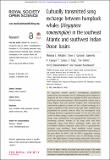Files in this item
Culturally transmitted song exchange between humpback whales (Megaptera novaeangliae) in the southeast Atlantic and southwest Indian Ocean basins
Item metadata
| dc.contributor.author | Rekdahl, Melinda L | |
| dc.contributor.author | Garland, Ellen Clare | |
| dc.contributor.author | Carvajal, Gabriella A | |
| dc.contributor.author | King, Carissa D. | |
| dc.contributor.author | Collins, Tim | |
| dc.contributor.author | Razafindrakoto, Yvette | |
| dc.contributor.author | Rosenbaum, Howard | |
| dc.date.accessioned | 2018-11-29T12:30:05Z | |
| dc.date.available | 2018-11-29T12:30:05Z | |
| dc.date.issued | 2018-11 | |
| dc.identifier | 252136108 | |
| dc.identifier | 9120e506-7080-46a4-b5b0-f15054af8167 | |
| dc.identifier | 85058385301 | |
| dc.identifier | 000451777500003 | |
| dc.identifier.citation | Rekdahl , M L , Garland , E C , Carvajal , G A , King , C D , Collins , T , Razafindrakoto , Y & Rosenbaum , H 2018 , ' Culturally transmitted song exchange between humpback whales ( Megaptera novaeangliae ) in the southeast Atlantic and southwest Indian Ocean basins ' , Royal Society Open Science , vol. 5 , 172305 . https://doi.org/10.1098/rsos.172305 | en |
| dc.identifier.issn | 2054-5703 | |
| dc.identifier.other | ORCID: /0000-0002-8240-1267/work/51261118 | |
| dc.identifier.uri | https://hdl.handle.net/10023/16574 | |
| dc.description | Funding: E.C.G. was funded by a Royal Society Newton International Fellowship and Royal Society University Research Fellowship. | en |
| dc.description.abstract | In migratory marine species, investigating population connectivity and structure can be challenging given barriers to dispersal are less evident and multiple factors may influence individual movement patterns. Male humpback whales sing a song display that can provide insights into contemporary connectivity patterns, as there can be a cultural exchange of a single, population-wide shared song type with neighbouring populations in acoustic contact. Here, we investigated song exchange between populations located on the east and west coasts of Africa using 5 years of concurrent data (2001–2005). Songs were qualitatively and quantitatively transcribed by measuring acoustic features of all song units and then compared using both Dice’s similarity index and the Levenshtein distance similarity index (LSI) to quantitatively calculate song similarity. Song similarity varied among individuals and potentially between populations depending on the year (Dice: 36–100%, LSI: 21–100%), suggesting varying levels of population connectivity and/or interchange among years. The high degree of song sharing indicated in this study further supports genetic studies that demonstrate interchange between these two populations and reinforces the emerging picture of broad-scale connectivity in Southern Hemisphere populations. Further research incorporating additional populations and years would be invaluable for better understanding of fine-scale, song interchange patterns between Southern Hemisphere male humpback whales. | |
| dc.format.extent | 15 | |
| dc.format.extent | 1021364 | |
| dc.language.iso | eng | |
| dc.relation.ispartof | Royal Society Open Science | en |
| dc.subject | Song | en |
| dc.subject | Humpback whale | en |
| dc.subject | Population structure | en |
| dc.subject | Cultural transmission | en |
| dc.subject | Africa | en |
| dc.subject | GC Oceanography | en |
| dc.subject | QH301 Biology | en |
| dc.subject | DAS | en |
| dc.subject | SDG 14 - Life Below Water | en |
| dc.subject.lcc | GC | en |
| dc.subject.lcc | QH301 | en |
| dc.title | Culturally transmitted song exchange between humpback whales (Megaptera novaeangliae) in the southeast Atlantic and southwest Indian Ocean basins | en |
| dc.type | Journal article | en |
| dc.contributor.sponsor | The Royal Society | en |
| dc.contributor.sponsor | The Royal Society | en |
| dc.contributor.institution | University of St Andrews. School of Biology | en |
| dc.contributor.institution | University of St Andrews. Sea Mammal Research Unit | en |
| dc.contributor.institution | University of St Andrews. Centre for Social Learning & Cognitive Evolution | en |
| dc.contributor.institution | University of St Andrews. Centre for Biological Diversity | en |
| dc.identifier.doi | https://doi.org/10.1098/rsos.172305 | |
| dc.description.status | Peer reviewed | en |
| dc.identifier.grantnumber | NF140667 | en |
| dc.identifier.grantnumber | UF160081 | en |
This item appears in the following Collection(s)
Items in the St Andrews Research Repository are protected by copyright, with all rights reserved, unless otherwise indicated.

